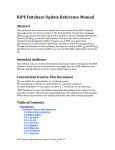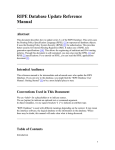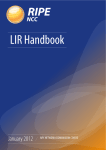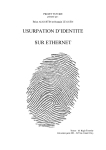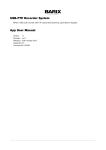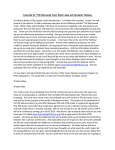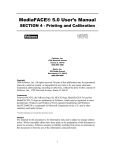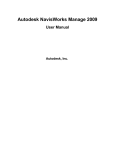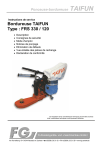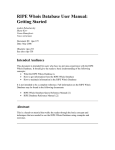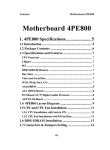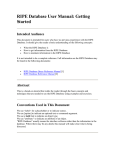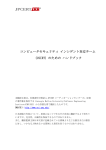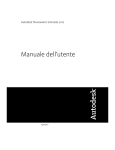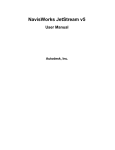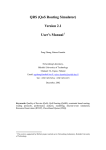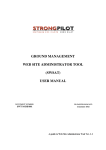Download RIPE Database Query Reference Manual Abstract
Transcript
RIPE Database Query Reference Manual Abstract This document describes how queries work in the current version of the RIPE Database. This version uses the Routing Policy Specification Language (RPSL) [1] to represent many of the database objects. It uses the Routing Policy System Security (RPSS) [2] for authorisation. This means better security for Internet Routing Registries (IRR). It makes use of RPSL next generation specifications [14]. Though this document is self-contained, you may also wish to read the RPSL [1] and RPSS [2] specifications. For a tutorial on RPSL, you can read the RPSL applications document [3]. You may also want to read the “RIPE Database Update Reference Manual” [19]. It explains how updates work in the RIPE Database. There is also a single page “Whois Queries Reference Card” [18]. Intended Audience This reference manual is for casual and advanced users who query the RIPE Database. If you are new to this database, you might find the “RIPE Database User Manual – Getting Started” [5] to be a more helpful place to start. Conventions Used in This Document We use <label> for a placeholder or to indicate syntax. We use [option] to indicate an optional text or command argument. We use a bold font to indicate an object type. We use “attribute:” to indicate an attribute of an object. “RIPE Database” usually means the user interface rather than the information in the database. Where there may be any doubt, this manual will make clear what is being discussed. Table of Contents • RIPE Database Query Reference Manual • Abstract • Intended Audience • Conventions Used in This Document • Table of Contents • Introduction o 1.0 Database Objects and Attributes o 2.0 Querying the RIPE Database o 2.1 Queries Using Primary and Lookup Keys o 2.2 Queries for IP Networks 2.2.1 Default Queries for IP Networks 2.2.2 Exact Match Queries RIPE Database Query Manual, Software Version 1.75 • • 2.2.3 More and Less Specific Queries 2.2.3.1 More Specific Queries 2.2.3.2 Less Specific Queries 2.2.4 Less Specific Queries Referencing irt Objects o 2.3 Queries for Autonomous Systems o 2.4 Inverse Queries o 2.5 Abuse Contacts o 2.6 Grouping the RIPE Database Output o 2.7 Filtering the RIPE Database Output o 2.8 Query Support for Tools 2.8.1 IRRToolset Support 2.8.2 Persistent Connections and Keeping State o 2.9 Getting All the Members of Set Objects o 2.10 More and Less Specific Lookups For Reverse Domains o 2.11 Access Control for Queries o 2.12 Other Server Features 2.12.1 RIPE NCC Mirrors of Other Databases 2.12.2 The "–q" Query Flag 2.12.3. The “-t” Query Flag 2.12.4. The “-v” Query Flag 2.12.5. The “-F” Query Flag 2.12.6. The “-K” Query Flag 2.12.7. The “-T” Query Flag 2.12.8. The “-a” Query Flag Tables of Query Types Supported by the RIPE Database o Table 2.1 Queries Using Primary and Lookup Keys o Table 2.2 Queries For IP Networks o Table 2.3 Query Flag Arguments to the "-i" Query Flag and the Corresponding Inverse Keys o Table 2.4 Query Support For Tools o Table 2.5 Miscellaneous Queries o Table 2.6 Informational Queries Appendices o A1. RIPE Database Query Server Response Codes and Messages A1.1 Query Errors A1.2 Access Errors A1.3 Connection Errors A1.4 NRTM Errors A1.5 Warnings RIPE Database Query Manual, Software Version 1.75 o A2. Copyright Information A2.1 RIPE Database Copyright A2.2 RIPE NCC Copyright • Acknowledgements • References Introduction The RIPE Network Management Database (often called the “RIPE Database”) contains information about IP address space allocations and assignments, routing policies, reverse delegations and contacts in the RIPE NCC service region [16]. The data itself is a mix of registry information entered and maintained by the RIPE NCC and related data entered and maintained by RIPE NCC members and other users. While the information in the RIPE Database is made freely available to the public, it is subject to the RIPE Database Terms and Conditions [22]. 1.0 Database Objects and Attributes The RIPE Database contains records of: • Allocations and assignments of IP address space (the IP address registry) • Reverse domain registrations • Routing policy information (the Internet Routing Registry) • Contact information - details of people who are registered as the contacts for the Internet number resources used in the operation of networks or routers and their organisations The RIPE NCC maintains the Internet number resources in the database that are allocated or assigned by the RIPE NCC. These resource objects are tagged as “RIPE-REGISTRY-RESOURCE”. For other resource objects tagged as “RIPE-USER-RESOURCE”, the registered contacts (Registrants) and the holders of the referenced mntner objects maintain this data. A database object is defined in RPSL as a list of attribute-value pairs in plain text form. Attributes can be mandatory, optional or generated. Mandatory attributes will always be present in an instance of an object. Optional attributes may be present if considered necessary or useful by the creator of the object or if required by the business rules in the software. Generated attributes can be included by the creator of the object, but their values will always be checked and included, when necessary, by the database software. The attributes are indexed in a number of ways to allow the queries to search the database. An attribute can be a primary key, lookup key, inverse key, or a combination of these, or a part of one of these. The characteristics of an attribute are determined by the type of object the attribute appears in. These are shown for each object in the object templates. They can be listed using the query: whois –t <object-type> There is also a detailed description available by querying: whois –v <object-type> 2.0 Querying the RIPE Database RIPE Database Query Manual, Software Version 1.75 This section describes how you can find information by querying the RIPE Database. We describe the general format of a query and the query flags that you can use to change the default behaviour of a query. We also describe how the database server automatically tracks query responses and limits how much contact information you can take from the RIPE Database. We do this to reduce the chance that someone will use the database to send spam e-mails to addresses that they find. There are four ways to query the database: • Using a whois client running the whois protocol [12] • Using the web interface from the RIPE NCC website [20] • Using telnet to port 43 of the whois.ripe.net host • Using the REST API running at rest.db.ripe.net There is a set of general rules about server responses: The same response will be returned from the server for each of these four methods. Output lines starting with the % sign are either a server response code or server messages (a comment, information message or an error with description). A message contains a white space after the % sign, while a server response code line starts right after the % sign. See Appendix A2, “RIPE Database Query Server Response Codes and Messages” for more information. Do not write scripts to parse the messages. The text is subject to change at any time. A database object in the output is terminated by an empty line. This is a line containing only a newline character (\n). Two empty lines, each containing only a newline character (\n), mean the end of a server response. The general format of a query is: [optional query flags] <query argument> The format of a query flag is: -short_query_flag [optional query flag argument] or --long_query_flag [optional query flag argument] You may list each query flag separately, as in: -B –i tech-c --no-grouping ABC999-RIPE You can also group together short query flags. In this case, only the last flag in a list may have a flag argument, as in: -Bi tech-c --no-grouping ABC999-RIPE You can find a list of query flags and query flag arguments in Tables 2.1 to 2.6. 2.1 Queries Using Primary and Lookup Keys Most queries use the primary and lookup keys of an object as an argument to the query. You can find a list of these queries in Table 2.1 at the end of this section. 2.2 Queries for IP Networks The RIPE Database provides information about IP networks allocated or assigned within the RIPE NCC service region [16]. This information is mainly stored as inetnum, inet6num, route and route6 objects. These objects store information about a single IP address or ranges of addresses. RIPE Database Query Manual, Software Version 1.75 The route and route6 objects use “prefix notation” to specify the single address or range of addresses about which they contain information. “Prefix notation” specifies ranges using two parts: the prefix and its length. • For IPv4, the prefix is a 32-bit integer written in dotted quad notation with the value of the lowest IP address in the range. The prefix length is a whole number in the range 0-32 (for example 193.0.0.0/22 specifies the range of 1024 IPv4 addresses starting with, and including, 193.0.0.0). • For IPv6 address ranges, the prefix length must be in the range 0-128 and is a 128-bit whole number, written in hexadecimal groups of two bytes separated by colons and with the possible use of shorthand notation for strings of consecutive 0s. The inetnum objects represent an IPv4 address space in range notation where the range is explicitly specified as two 32-bit whole numbers written in dotted quad notation separated by a dash (for example 193.0.0.0 - 193.0.3.255, this is the same range as in the above example). The inet6num objects represent IPv6 address space. Only the standard IPv6 prefix notation is allowed (as described above). When you query the database for information about IP addresses, you can specify query arguments as search keys with the following notations: • A prefix (this has the same meaning as above). • An explicit range (also as above). • A single IP number. This is interpreted as a range of just one address for IPv4 or a prefix length of one for IPv6. For IPv4 address space, the query argument can be specified with either prefix or range notation. When prefix notation is used, the server software converts this into range notation before it executes the query. An information message is included in the server output showing the conversions performed. For IPv6 address space, the query argument can only be specified in prefix notation. You can find a list of queries for IP networks in Table 2.2 at the end of this section. The rest of this section describes how you can retrieve different types of information relative to a particular range of IP addresses. We use three terms in these types of queries. These are all defined relative to the specified (reference) range: • An exact match refers to a range that is identical to the reference range. • A more specific range is contained within the reference range and is smaller. It contains fewer IP addresses than the reference range. We also call this a sub range. • A less specific range contains the whole of the reference range and is bigger. It has a greater number of IP addresses than the reference range. We also call this an encompassing range. 2.2.1 Default Queries for IP Networks If you do not specify a query flag, and your query argument is a range of IP addresses in any one notation, the RIPE Database server will try to find an exact match for that range. If found, the exact match is returned. If an exact match cannot be found, the server looks for the smallest less specific range. This will be the smallest existing, encompassing range. 2.2.2 Exact Match Queries If you want to change the default behaviour, so that the server returns only an exact match, you need to use the “–x” query flag. This flag stops the server from looking for any less specific ranges if no exact match exists, not even the smallest encompassing range will be returned. 2.2.3 More and Less Specific Queries RIPE Database Query Manual, Software Version 1.75 If the exact match is not the information you wanted, you can modify the information returned by the database server, by using one of these query flags which provide two generic types of queries known as more and less specific queries: “-M”, “-m”, “-L” and “-l”. 2.2.3.1 More Specific Queries These refer to queries qualified by the use of the “-M” and “-m” query flags. These will return information about ranges of IP addresses that are fully contained in the usersupplied reference range and contain fewer addresses. More specific queries do not return the exact match. • “-M” - requests that the server should return all the sub-ranges completely contained within the reference range. When there are hierarchies of sub-ranges, all of these will be returned down to the smallest sub-ranges. • “-m” - requests that the server should return all sub-ranges that are completely contained within the reference range. When there are hierarchies of sub-ranges, only the top level of the hierarchies will be returned. These are usually called one level more specific ranges. 2.2.3.2 Less Specific Queries These refer to queries qualified by the use of the “-L” and “-l” query flags. These will return information about ranges of IP addresses that fully contain the user-supplied reference range and may contain a greater number of addresses. • “-L” - requests that the server returns the exact match, if any, and all encompassing ranges that are bigger than the reference range and that fully contain it. • “-l” - requests that the server does NOT return the exact match. It returns only the smallest of the encompassing ranges that is bigger than the reference range and that fully contains it. This is usually referred to as the “one level less specific range”. 2.2.4 Less Specific Queries Referencing irt Objects In this section, “inet(6)num” is used to mean “inetnum or inet6num”. This is to make the text clearer. An irt object represents a Computer Security Incident Response Team (CSIRT). It includes contact and security information. It is optionally referenced from inet(6)num objects using the “mnt-irt:” attribute (even though the irt object is not a mntner). This shows which CSIRT is responsible for handling computer and network incidents for that address range. A reference to an irt object does not apply only to the inet(6)num object that contains the reference. It also applies to all the inet(6)num objects that are “more specific” to the one containing the reference. Not every inet(6)num object needs to contain a reference to the irt object. The irt reference only needs to be placed in the least specific encompassing object to apply to a whole hierarchy of objects. This makes it easier to apply and maintain. There may be more than one inet(6)num object in a hierarchy referencing an irt object. In this case, the one referenced from the smallest encompassing object is the one that applies to the range in question. There is a “-c” query flag to make it easy to find the inet(6)num object containing the reference to an irt object for any specific range. This flag makes the server search up the hierarchy from the range specified as the query argument. The search will stop when the first object is found containing a reference to an irt object. This can either be the specified range or an encompassing inet(6)num object. The query will return the inet(6)num object found for the specified range. The irt object will also be returned along with the usual contact data objects. RIPE Database Query Manual, Software Version 1.75 Sometimes, no inet(6)num object is found in the hierarchy containing a reference to an irt object. In this the query will return only the inet(6)num object found for the specified range. 2.3 Queries for Autonomous Systems AS numbers can be either 32-bit or 16-bit. They are both described by a 32-bit number. From the point of view of the RIPE Database there is no difference. The difference is mainly historical. 2.4 Inverse Queries Inverse queries are performed using an object’s inverse key as an argument to a query. The query flag “-i” (or --inverse) must also be specified with appropriate query flag arguments. Inverse keys are defined in the templates of the RIPE Database objects. These can be listed using the query: whois –t <object type> Table 2.3, at the end of this section, gives a complete listing of the inverse query flag arguments. By performing this type of query, the user requests all objects to be returned by the database that reference the specified query argument in the attribute(s) specified in the query flag arguments. As an example: whois -i admin-c <nic-handle> will return all objects where the “admin-c:” attribute contains the <nic-handle> specified as the query argument. You can specify several query flag arguments to request searches against several attributes in objects. If you want to do this, the query flag arguments should be entered as a comma-separated list with no white spaces. All the attributes searched must contain the same type of value. In other words, all the values must be maintainers or nic-handles or one of the other values listed in Table 2.3. As an example: whois --inverse mb,mnt-lower <mntner name> will return all objects where the “mnt-by:” or the “mnt-lower:” attributes contain the <mntner name> specified as the query argument. 2.5 Abuse Contacts There are many attributes in objects within the RIPE Database containing e-mail addresses. These addresses cover a number of functions. A growing concern to engineers and administrators that maintain networks is receiving spam and abuse complaints that are sent to every e-mail address displayed. This will get the message to the right person, but it also causes more spam and abuse to people who are not responsible for solving these problems. To solve this issue, an “abuse-c:" attribute is available in the organisation object. This optional attribute references a role object which is required to contain an optional “abuse-mailbox:” attribute. Any Internet resource object (inetnum, inet6num, aut-num) that references this organisation object is then “covered” by this abuse email address. By default, any query for an Internet resource object will return the related abuse email address. This appears in the query output as a comment line (starting with the % ’ characters). There is also a “-b” query flag to find the “abuse-mailbox:” attributes for any specific range. It returns the resource primary key with any abuse contact email address found. Also the prefix of any corresponding route or route6 objects, followed by the “abuse-mailbox:” attributes. If no abuse contact is found in any encompassing objects then no object summaries will be returned. RIPE Database Query Manual, Software Version 1.75 A complaint will not be handled any quicker by copying your message to any other e-mail address found in the database. The “-b” query flag cannot be used with many other query flags. 2.6 Grouping the RIPE Database Output There are two ways to order the results of a query. One way is for the first part of the results to list the primary objects like inetnum and mntner. Then the second part of the results lists all the secondary objects associated with the primary objects, like organisation and person. If any of these secondary objects are referenced by more than one of the returned objects, it will only be listed once in the returned results. The other way is to group the returned objects to show the association between the primary and secondary objects. In this way, each of the primary objects is followed immediately by all of its secondary objects. The secondary objects may appear more than once in this type of output. The default output is grouped. If you include the “-G” or “--no-grouping” query flag then the output will not be grouped. 2.7 Filtering the RIPE Database Output A filtering process restricts some data from default query results. This applies to e-mail contact data. When a user is searching for abuse contact data, they sometimes take all e-mail addresses found in all objects returned from a query. This may include the correct address. However, it often also includes many other addresses for people who are not responsible for handling such complaints. To help overcome this issue, some attributes containing e-mail addresses are filtered out of the default output. One exception to this is where a role object includes an “abuse-mailbox:” attribute. The abuse email address is never filtered. If you include the “-B” or “--no-filtering” query flag then the output will not be filtered When any attribute has been filtered out of an object in the query results returned to the user, a “Note:” is added to the output to warn the user. In addition, the “source:” attribute of each filtered object will have a comment added to the end of the line saying “# Filtered”. If this filtered output is cut and pasted into an update message, including this end of line comment on the “source:” attribute, the update will fail. This is because some mandatory attributes will be missing and the “source:” will not be recognised. Filtered output can therefore not be accidentally used for updates. The MD5 hash in the “auth:” attribute of mntner objects is always filtered when these objects are queried. This filtering cannot be turned off with any query flags. The only way to see an unfiltered mntner object is to query it for update in the Webupdates form and enter a valid password for the object. 2.8 Query Support for Tools There are several query types in the RIPE Whois Server that support various client tools. Other whois clients can also use these. 2.8.1 IRRToolset Support The IRRToolset [6] is a third party suite of routing policy analysis tools. Some of the tools in this set access Routing Registry servers through an authorisation whois interface. The RIPE Database Server includes support for these query types. This section describes the additions to the RIPE Database user interface that allow it to support the IRRToolset. The required queries are: • Return the prefixes of all route and route6 objects with a specified origin • Return only the primary keys of the route and route6 objects, not full objects • Return the prefixes of all route and route6 objects referenced in a given route-set RIPE Database Query Manual, Software Version 1.75 • Return all the members (aut-num or as-set object) of a specified as-set • Return only the “members:” attributes, not the full object • Optionally, include support for expansion of the previous query, if the returned value contains references to as-sets, so that the result contains only a list of aut-num objects The RIPE Database server does not support this and it is up to the client to perform the expansion. The IRRToolset currently does the expansion. • Return route and route6 objects that exactly match a specified prefix • Return route and route6 objects that exactly match a specified prefix (as above), but return only the “route:” or “route6:” attributes Table 2.4, at the end of this section, gives details of query support for tools. 2.8.2 Persistent Connections and Keeping State If you are carrying out batched queries, your database client can request a persistent connection. The server will not close this connection after sending a reply to your client. This avoids having to set up a new TCP connection for every query. The client can request this by sending the “-k” or “--persistent-connection” query flag to the server. This flag may be sent without a query argument to start the connection. It may also be included as a query flag with the first query. During a persistent connection, the server operates a “stop-and-wait” protocol. This means that the next query cannot be sent until the reply has been received to the previous query. If you want to be able to send queries in batch mode, you must use the RIPE whois client. To exit a persistent connection, send the “-k” or “--persistent-connection” flag with no query argument or an empty query (\n) to the server. The connection will also time out after a period of inactivity. 2.9 Getting All the Members of Set Objects In RPSL [3], an object can be a member of a set object in two ways. • You can list objects in a “members:” attribute in the set object. This is the kind of member relationship present in “Representation of IP Routing Policies in a Routing Registry” [4]. • You can use the “member-of:” attribute. You can use this in route, route6, aut-num and inet-rtr object types. The value of the “member-of:” attribute identifies a set object that this object wants to be a member of. However, just specifying “member-of:” is not enough. The referenced set object must also have a “mbrs-by-ref:” attribute. This lists the maintainer of the object that wants to be a member of the set. This means that the set owner must validate the membership claim of an object with a “member-of:” attribute. It does this by matching the “mnt-by” line of the object with one of the maintainers in the “mbrs-by-ref:” attributes of the set object. 2.10 More and Less Specific Lookups For Reverse Domains The RIPE Database supports IP network queries including the “-x”, “-M”, “-m”, “-L” and “-l” functionality for reverse delegation domains. To request that reverse delegation domains be queried for with the more (or less) specific query flags, you must also include the “-d” query flag. Note that there is no hierarchy allowed with reverse domain objects. These queries work on the address space hierarchies and return the corresponding domain object, if found, for any address space object. 2.11 Access Control for Queries RIPE Database Query Manual, Software Version 1.75 The control mechanism is based on the amount of contact information (contained in person and role objects) that is returned because of any queries made. Limits are based on the IP address of a whois client sending queries to the database server. Sometimes an IP address may be acting as a proxy and submitting queries on behalf of other IP addresses (for example, a webserver providing an interface to the RIPE Database). The database server provides a facility for such proxy clients that allows accounting to be based on the IP address of the clients using the proxy to query the RIPE Database and not on the IP address of the proxy server. This is done using the “-V” flag as follows: -V <version>,<ipv4-address> where • <version> is a client tag that usually represents the software version that the proxy uses • <ipv4-address> is the IPv4 address of the client that queries the database using the proxy Not all users can use this “-V” flag. You must contact RIPE Database Administration and tell us why you need this facility. If we approve your request, we will add the IP address of the proxy server to an access control list. You can then use the “-V” flag, but only from your stated IP address. Attempting to use the “-V” flag without approval may result in permanent denial of access to the RIPE Database. This denial of access will apply to the IP address that submits the query. We restrict access to stop people using the RIPE Database to collect excessive amounts of contact data. If the amount of contact data returned by all your queries in a day (defined by Amsterdam time) exceeds defined limits, a temporary block on access is applied to that IP address. This block will be automatically released at midnight (Amsterdam time) to allow querying to continue. There is also a limit on the number of times an IP address can be blocked and recover. When this limit is reached, that IP address is permanently blocked from accessing the RIPE Database. This permanent block will not be automatically removed. The limits are defined in the RIPE Database Acceptable Use Policy [23]. There are many reasons why you could find yourself in this position. One is that you are mining the RIPE Database for contact data to use for non-agreed purposes. In this case, the denial of access is justified and your IP address will remain on the blocked list. However, there may be other reasons. Queries for object types other than person and role objects return contact information by default. Using the “-r” or “--no-referenced” flag to prevent contact data being included in your query results can turn off this default. Alternatively, you may have an error in a script that runs automatically, retrieving contact data that you did not know about. If you believe there was a genuine error or mistake that led to the permanent block, you need to contact RIPE Database Administration. Explain the error and tell us what steps you have taken to stop it happening again. RIPE Database Administration will decide whether to remove the block. It will remain on record that this IP address has been permanently blocked and unblocked. If another permanent block occurs, we will be less likely to consider removing it a second time. Each time a person or role object is retrieved, a counter increases. When it reaches the limit defined in the AUP [23], the query execution is aborted and the connection is terminated, displaying an error message to the client (see “Access errors” in Appendix A1, "RIPE Database Query Server Response Codes and Messages"). Also a count of denials increases. Retrieving any other object type does not affect these counters. Any role object used for abuse contacts with an “abuse-mailbox:” attribute is exception to this rule. No accounting is done on these objects. There is also a limit on the number of simultaneous connections from a host. When this limit is reached, further connections from the same host are refused. If we block your access, you will not be able to query for any object types. We will not just block your access to contact date alone. RIPE Database Query Manual, Software Version 1.75 2.12 Other Server Features 2.12.1 RIPE NCC Global Resource Service The RIPE NCC mirrors several other databases, in near real time, that are considered to be of use to anyone who queries the RIPE Database. These include the other Regional Internet Registries [24]. This allows queries to the RIPE Database to retrieve information from one or more of the mirrored databases. A local copy is maintained of each mirrored database. Daily updates are obtained from the mirrored databases to keep the local copies up to date. The mirrored databases are referenced by the source of the data. A list of currently available sources and the data they can provide can be obtained by using the “-q” query flag. This is described in Section 2.12.2. All mirrored databases are made available by the RIPE NCC in RPSL syntax with the same RPSL extensions as the RIPE Database. If the mirrored data stream has some other syntax, it is converted into RIPE Database syntax before submission to the local database copy. This means that the data returned to a user who queries a RIPE NCC mirror may not be in the same format as data returned by querying the original database directly. Users can query the RIPE NCC mirrored databases as if they were querying the RIPE Database by adding the “-s” or "-a” query flags. Bulk access to any of the mirrored databases is not possible. The Access Control mechanism described in Section 2.12 applies to all data returned, regardless of the source. 2.12.2 The “–q” Query Flag The RIPE Database server supports the retrieval of certain information about itself and the data sets served, using a “-q” query flag. The “-q” query flag requests the server to reply with information about the system setup. It does not return any information extracted from any of the databases that it serves. This query flag takes a single argument which has three possible values: • Version (usage: -q version). This will display version information for the server software • Types (usage: -q types). This will list all the object types recognised by the RIPE Database • Sources (usage: -q sources). This will list all available sources. That is, the local RIPE Database and all the mirrored databases 2.12.3. The “-t” (“--template”) Query Flag This query flag returns to the user a brief description of the specified object type. 2.12.4. The “-v” (“--verbose”) Query Flag This query flag returns to the user a verbose description of the specified object type. 2.12.5. The “-F” (“--brief”) Query Flag This query flag changes the format of the returned objects. The attribute names are represented in a short hand notation. For example, "person:" becomes "*pn:". Using the –F query flag includes the non-recursive action of the –r query flag. 2.12.6. The “-K” (“--primary-keys”) Query Flag This query flag returns only the primary keys of each object. There are some exceptions to this: • With set objects, the "members:" attributes will also be returned. RIPE Database Query Manual, Software Version 1.75 • No information is returned for person, role or organisation objects. If a query would normally only return these types of objects, no data is returned. In this case you do not get the "ERROR:101: no entries found". The entries were found but filtered because of using the "-K" flag. 2.12.7. The “-T” (“--select-types”) Query Flag This query flag restricts the type of the objects returned. The query flag argument is a commaseparated list of object types. 2.12.8. The “-a” (“--all-sources”) Query Flag This query flag requests that the server searches all the sources available to it. These are the sources listed by using the “–q sources” query. 2.13 Tagging The RIPE Database allows system tags to be added to any (group of) objects. This is meta data that gives some additional information or meaning to certain objects. For example, all resource objects maintained by the RIPE NCC are tagged with “RIPE-REGISTRY-RESOURCE”. Other resources created in the database by users that are more specific to objects tagged with “RIPEREGISTRY-RESOURCE” are tagged with “RIPE-USER-RESOURCE”. Currently these tags are only generated by the database software and are re-generated nighty. Tables of Query Types Supported by the RIPE Database Table 2.1 Queries Using Primary and Lookup Keys There are side effects to these types of queries. Other objects may be returned besides the ones that you are expecting. For example, if you enter a netname you may only expect to get back the inetnum and inet6num objects with this netname. You will also get any person, role or mntner objects back whose name matches the netname specified. The query is done as a text search on the primary and lookup keys. So any object with a matching string will be returned. The results can be limited by using the “–T” option to specify the object types you are interested in. Lookup Key(s) Objects Returned inetnum, route objects with exact match on the specified key. If the <ip-lookup> (IPv4 exact match does not exist, the objects with the smallest less specific address prefix, range or match are returned. When you specify a single address, an inet-rtr single address) object whose “ifaddr:” attribute matches the query argument is also returned. inet6num, route6 objects with exact match on a specified key. If the <ip-lookup> (IPv6 exact match does not exist, the objects with the smallest less specific address prefix or single match are returned. If you specify a single address, an inet-rtr object address) whose “interface:” attribute matches the query argument is also returned. <netname> inetnum and inet6num objects whose “netname:” attribute matches the query argument. <as-number> aut-num object whose “aut-num:” attribute matches the query argument and an as-block object with the range containing the autnum object, if it exists. <as-number> - <asas-block object whose primary key defines a range that exactly matches number> (range of <as- or fully contains the range specified in the query argument. number> separated by RIPE Database Query Manual, Software Version 1.75 “-“) <reverse-domain> domain and inet-rtr objects whose primary keys match the query argument. <irt-name> irt object whose primary key matches the query argument. <Person-name> person and role objects whose “person:” or “role:” attributes contain the name specified in the query argument. <set-name> A set whose primary key matches the query argument. <nic-handle> person or role object whose “nic-hdl:” attribute matches the query argument. <mntner-name> mntner object whose primary key matches the query argument. <org-id> organisation object whose primary key matches the query argument. <key-cert-id> key-cert object whose primary key matches the query argument. <poem> poem object whose primary key matches the query argument. <poetic-form> poetic-form object whose primary key matches the query argument. Table 2.2 Queries For IP Networks Flag -x --exact -M --all-more Lookup Key(s) Objects Returned or Effect <iplookup> Only inetnum, inet6num, route, route6 or domain objects that exactly match the prefix. If no exact match is found, no objects are returned. <iplookup> All level more specific inetnum, inet6num, route, route6 or domain objects, excluding exact matches. -m <ip--one-more lookup> First level more specific inetnum, inet6num, route or route6 objects, excluding exact matches. -L <iplookup> All level less specific inetnum, inet6num, route, route6 or domain objects, including exact matches. <iplookup> First level less specific inetnum, inet6num, route, route6 or domain objects, excluding exact matches. <iplookup> When used with “-x”, “-M”, “-m”, “-L” and “-l” flags, both address and route object types and domain object types are returned. <iplookup> The smallest, less specific inetnum or inet6num object found encompassing the range specified in the query argument. --all-less -l --one-less -d --reversedomain -c --irt Also any irt objects found referenced from the returned inetnum or RIPE Database Query Manual, Software Version 1.75 inet6num, or referenced from the first less specific inetnum or inet6num to the returned object that has such a reference. -b --abusecontact Provides a brief output of ranges with associated abuse contact information. Table 2.3 Query Flag Arguments to the “-” Query Flag and the Corresponding Inverse Keys. Flag Argument (Alternative Form) Lookup Key(s) Objects Returned am <e-mail> (abuse-mailbox) Objects whose “abuse-mailbox:” attribute matches the query argument. ac (admin-c) <nic-handle> or <person-name> Objects whose “admin-c:” attributes match the query argument. at (auth) <key-cert-id> mntner objects whose “auth:” attribute matches the query argument. Please note that encrypted passwords and SSO usernames cannot be inverse-searched, but only PGPKEY and X509 certificates. fp (fingerprint) <fingerprint> key-cert objects whose “fingerpr:” attribute matches the query argument. pn (person) <nic-handle> or <person-name> Objects whose “admin-c:”, “tech-c:”, “zone-c:” or “author:” attribute matches the query argument. iy (irt-nfy) <e-mail> irt objects whose “irt-nfy:” attribute matches the query argument. la (local-as) <as-number> inet-rtr objects whose “local-as:” attribute matches the query argument. mi (mnt-irt) <irt-name> inetnum and inet6num objects whose “mnt-irt:” attribute matches the query argument. mr (mbrs-by-ref) <mntner-name> Set objects (as-set, route-set and rtr-set) whose “mbrs-byref:” attribute matches the query argument. mo (member-of) <set-name> Objects whose “member-of:” attribute matches the query argument and their membership claim is validated by the “mbrs-by-ref:” attribute of the set. Absence of the “mbrs-byref:” attribute means that the membership is only defined by the “members:” attribute of the set. mb (mnt-by) <mntner-name> Objects whose “mnt-by:” attribute matches the query argument. md (mnt-domains) <mntner-name> Objects whose “mnt-domains:” attribute matches the query argument. RIPE Database Query Manual, Software Version 1.75 ml (mnt-lower) <mntner-name> Objects whose “mnt-lower:” attribute matches the query argument. mn (mnt-nfy) <e-mail> mntner objects whose “mnt-nfy:” attribute matches the query argument. mu (mnt-routes) <mntner-name> aut-num, inetnum, route and route6 objects whose “mntroutes:” attribute matches the query argument. mz (mnt-ref) <mntner-name> Returns all objects whose “mnt-ref:” attribute matches the query argument. ny (notify) <e-mail> Objects whose “notify:” attribute matches the query argument. ns (nserver) <domain-name> or <ip-lookup> domain objects whose “nserver:” attribute matches the query argument. (IPv4/IPv6 address) or (origin) <as-name> route and route6 objects whose “origin:” attribute matches the query argument. org <org-id> Objects whose “organisation:” attribute matches the query argument. tc (tech-c) <nic-handle> or <person-name> Objects whose “tech-c:” attribute matches the query argument. dt (upd-to) <e-mail> mntner objects whose “upd-to:” attribute matches the query argument. zc (zone-c) <nic-handle> or <person-name> Objects whose “zone-c:” attribute matches the query argument. Table 2.4 Query Support For Tools Flag Lookup Key(s) -F --brief -K --primarykeys -k (optional --persistent- normal connection query) Effect Produces output using shorthand notation for attribute names. Produces slower responses. Requests that only the primary keys of an object be returned. The exceptions are set objects, where the “members:” attributes will also be returned. This flag does not apply to person and role objects. Requests a persistent connection. After returning the result, the connection will not be closed by the server and a client may issue multiple queries on the same connection. The server implements a “stop-and-wait” protocol, whereby no next query can be sent before receiving a reply for the previous one. Use RIPE Whois client to be able RIPE Database Query Manual, Software Version 1.75 to send queries in batch mode. Except the first “-k query”, “-k” without an argument closes the persistent connection. Table 2.5 Miscellaneous Queries Flag Flag Argument -r Effect Switches off lookups for referenced contact information after retrieving the objects that match the lookup key. --noreferenced -B Switches off default filtering of objects. --no-filtering -G Switches off grouping of associated objects. --no-grouping Comma separated list of object Restricts the types of primary objects to lookup in types, no white space is the query. --select-types allowed. -T -a Specifies that the server should perform lookups in all available sources. See also “-q sources” query. --all-sources -s --sources Comma separated list of sources, no white space is allowed. Specifies which sources are to be looked up when performing a query and in which order. Shows a list of historical versions for the object. Can not be used on person or role objects. --list-versions --diff-versions <version-number: versionnumber> Indicates the difference between given historical versions of the object. --showversion <version-number> Returns the historical version of the object with this index number. Must use --list-versions to get the index numbers. --types Lists available RPSL object types. --version Displays the current software version. --list-sources Returns the current set of sources along with the information required for mirroring. --resource Search all sources for the specified resource and returns the authoritative one. Placeholders are omitted. --showpersonal Include referenced person and role objects in results. --no-personal Filter referenced person and role objects from RIPE Database Query Manual, Software Version 1.75 results. A client can be blocked for excessive querying of these objects. --show-taginfo Include tagging information for each object in the results. --no-tag-info Do not include any tagging information in the results. --filter-taginclude <tag> Return only objects with given tag in the results. --filter-tagexclude <tag> Filter out objects with given tag from the results. Table 2.6 Informational Queries The following notations are used in this table: <object-type> means full or abbreviated name; <client-tag> is a string without a white space that usually bears the name of the client’s software. Flag -q -q -t --template -v --verbose -V --client Flag Argument Effect sources Returns the current set of sources along with the information required for mirroring. version Displays the current version of the server. <object-type> Requests a template for the specified object type. <object-type> Requests a verbose template for the specified object type. <client-tag> Sends information about the client to the server. Appendices A1. RIPE Database Query Server Response Codes and Messages If the server encounters a problem, an error message is returned as a query result. The format of an error message is as follows: %ERROR:#:<message>, where # is the error or response code and <message> is a short description of the problem. There are no white spaces in this line, except in the <message> string. This may be followed by a more descriptive message, each line of which starts with % followed by a white space and some text. RIPE Database Query Manual, Software Version 1.75 Example: % This is the RIPE Database query server #1. % The objects are in RPSL format. % The RIPE Database is subject to Terms and Conditions. % See http://www.ripe.net/db/support/db-terms-conditions.pdf %ERROR:101: no entries found % % No entries found in the selected source(s). A1.1 Query Errors %ERROR:101: no entries found No entries were found in the selected source(s). %ERROR:102: unknown source Unknown source was supplied as argument to the “-s” query flag. Use “-q sources” for a list of available sources. %ERROR:103: unknown object type Unknown object type is specified as an argument to the “-T” query flag. %ERROR:104: unknown attribute Unknown argument is specified to the inverse query flag (“-I”). See Section 2.0, "Querying the RIPE Database" for more information. %ERROR:105: attribute is not searchable The argument specified for the inverse query flag is not a searchable attribute. See Section 2.0, "Querying the RIPE Database" for more information. %ERROR:106: no query argument specified No query argument has been specified in the query. %ERROR:107: input line too long Input exceeds the maximum line length. %ERROR:108: bad character in input An invalid character was passed in the query. The only allowed characters are letters, numbers and -_:+=.,@/?' %ERROR:109: invalid combination of flags passed The specified query flags cannot be included in the same query. %ERROR:110: multiple use of flag The same flag cannot be used multiple times. %ERROR:111: invalid option supplied Query flag that does not exist was given. Use the help query to see the valid options. %ERROR:112: unsupported query “-mM” query options are not allowed on very large ranges/prefixes. %ERROR:114: unsupported query Search key doesn't match any known query types. %ERROR:115: invalid search key Search key entered is not valid for the specified object type(s). %ERROR:116: unsupported query Versions are not supported for PERSON/ROLE objects. %ERROR:117: version cannot exceed X for this object RIPE Database Query Manual, Software Version 1.75 Versions are numbers greater or equal to 1 but cannot exceed the object's current version number. A1.2 Access Errors %ERROR:201: access denied Access from the host has been temporarily or permanently denied because of excessive querying. You should contact a customer service representative at [email protected] to discuss this problem. %ERROR:202: access control limit reached Limit of returned objects has been reached. The connection is terminated. Continued attempts to excessively query the database will result in permanent denial of service. See Section 2.11, “Access Control for Queries” for more information. %ERROR:203: address passing not allowed The host is not registered as a proxy and is not allowed to pass addresses on the query line (“-V” flag). See Section 2.11, “Access Control for Queries” for more information. A1.3 Connection Errors %ERROR:301: connection has been closed The connection is administratively or abnormally closed. %ERROR:302: referral timeout The connection was closed due to referral timeout. %ERROR:303: no referral host Referral host cannot be found. %ERROR:304: referral host not responding The connection to the referral host cannot be established. %ERROR:305: connection has been closed The connection to the server has been closed after a period of inactivity. %ERROR:306: connections exceeded Number of connections from a single IP address has exceeded the maximum number allowed. A1.4 NRTM Errors %ERROR:401: invalid range: Not within <first>-<last> This happens when the requested range or part of it is outside the serial numbers available at the server. <first> is the lowest serial number available. <Last> is the most recent serial number available. A1.5 Warnings %WARNING:901: duplicate IP flags passed More than one IP flag (-x, -M, -m, -L, -l, -c, or -b) was passed to the server. Only the last one in the list of query flags will be used for this query. %WARNING:902: useless IP flag passed An IP flag (-x, -M, -m, -L, -l, -c, or -b) was passed to the server when query did not include an IP key as the argument. A2. Copyright Information A2.1 RIPE Database Copyright RIPE Database Query Manual, Software Version 1.75 The information in the RIPE Database is available to the public subject to the RIPE Database Terms and Conditions [22]. A2.2 RIPE NCC Copyright © RIPE NCC. All rights reserved. Acknowledgements The authors wish to acknowledge the work done by the original developers of version 3.0 of the RIPE Database software and infrastructure at the RIPE NCC: Andrei Robachevsky, Daniele Arena, Marek Bukowy, Engin Gunduz, Roman Karpiuk, Shane Kerr, Ambrose M.R. Magee, Chris Ottrey and Filippo Portera. Those who have continued its development include Denis Walker, Katie Petruska, Agoston Horvath, Can Bican, Tiago Anteo, Jos I Boumans, Luis Motta Campos, Erik Broes and Menno Blom. Edward Shryane, Angela Sjoholm, Theodoros Polychniatis References [1] C. Alaettinoglu, C. Villamizar, E. Gerich, D. Kessens, D. Meyer, T. Bates, D. Karrenberg and M. Terpstra, “Routing Policy Specification Language (RPSL)”, RFC 2622, June 1999 [2] C. Villamizar, C. Alaettinoglu, D. Meyer and S. Murphy, “Routing Policy System Security”, RFC 2725, December 1999 [3] D. Meyer, J. Schmitz, C. Orange, M. Prior, and C. Alaettinoglu, “Using RPSL in Practice”, RFC 2650, August 1999 [4] T. Bates, E. Gerich, L. Joncheray, J.M. Jouanigot, D. Karrenberg, M. Terpstra and J. Yu, “Representation of IP Routing Policies in a Routing Registry”, ripe-181, October 1994. See http://www.ripe.net/docs/ripe-181.html [5] RIPE Database - Getting Started [6] IRRToolset. See http://www.isc.org/sw/IRRToolSet/ [7] P. Mockapetris, “Domain names - Concepts and Facilities”, RFC 1034, November 1987 [8] P. Resnick, ed., “Internet Message Format”, RFC 2822, April 2001 [9] J. Zsako, “PGP Authentication for RIPE Database Updates”, RFC 2726, December 1999 [10] N. Nimpuno, A.Robachevsky, “New Value of the “status:” Attribute for Inetnum Objects (LIRPARTITIONED)”, ripe-239, June 2002 [11] A. Cormack, D. Stikvoort, W. Woeber, and A. Robachevsky, “IRT Object in the RIPE Database”, ripe-254, July 2002 [12] K. Harrenstien, M.K. Stahl, E.J. Feinler. “NICNAME/WHOIS”, RFC 954, October 1985 [13] J.S.L. Damas and L. Vegoda, “New Values of the “status:” Attribute for inet6num Objects”, ripe-243, August 2002 [14] L. Blunk, J. Damas, F. Parent and A. Robachevsky, Routing Policy Specification Language next generation (RPSLng), RFC 4012 [15] C. Bican, RIPE 43 presentation on Webupdates, December 2002, http://www.ripe.net/ripe/meetings/ripe-43/presentations/ripe43-databasesyncupdates/index.html [16] RIPE NCC service region http://www.ripe.net/membership/maps/index.html RIPE Database Query Manual, Software Version 1.75 [17] The IANA ccTLD Database contains a full list of the ccTLD administrators, http://www.iana.org/cctld/cctld-whois.htm [18] RIPE Database Queries Reference Card [19] RIPE Database Update Reference Manual [20] RIPE Database web query, http://www.ripe.net/whois [21] Regional Internet Registries (RIR), http://www.ripe.net/info/resource-admin/index.html [22] Ripe Database Terms and Conditions, http://www.ripe.net/db/support/db-termsconditions.pdf [23] RIPE Database Acceptable Use Policy, http://www.ripe.net/datatools/support/documentation/aup [24] Regional Internet Registries - RIPE NCC, ARIN, APNIC, AFRINIC, LACNIC RIPE Database Query Manual, Software Version 1.75





















